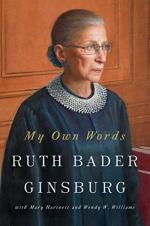|
This section contains 607 words (approx. 2 pages at 400 words per page) |

|
My Own Words Summary & Study Guide Description
My Own Words Summary & Study Guide includes comprehensive information and analysis to help you understand the book. This study guide contains the following sections:
This detailed literature summary also contains Topics for Discussion on My Own Words by Ruth Bader Ginsburg.
The following version of this book was used to create the guide: Ginsburg, Ruth Bader. Hartnett, Mary. Williams, Wendy W. My Own Words. Simon & Schuster, Inc., 2016.
My Own Words is a biographical collection of Ruth Bader Ginsburg's speeches, articles, and lectures. These works were selected and curated by Mary Hartnett and Wendy W. Williams. The coauthors have arranged the works in order to guide the reader from Ginsburg's adolescence through the latter half of her career. Hartnett and Williams' voices appear in the form of introductory and contextualizing passages throughout the text. The following summary condenses the selected works into linear summations.
In Part One: "Early Years and Lighter Side," the authors describe Ginsburg's early life with her Jewish parents. Though her mother had few opportunities as a woman, she encouraged Ginsburg to work hard in school and to always be independent. Ginsburg excelled in her academics and published many pieces in her school newspapers. Not long after her mother died of cancer, Ginsburg left home for university. There she met Marty Ginsburg, who she later married. Throughout her early academic career, Ginsburg became increasingly involved in gender equality and human rights issues. Her kindness and empathy later extended to her relationships with her colleagues on the Supreme Court. She was especially close with Justice Antonin Scalia. Though their opinions differed, they were lifelong companions.
In Part Two: "Tributes to Waypavers and Pathmarkers," the authors present a series of tributes Ginsburg wrote and delivered to prominent historical figures, or influential individuals. Over the course of these selected tributes, Ginsburg noted her respect and admiration for Belva Lockwood, Justices Benjamin, Brandeis, and Breyer, Emma Lazarus, Anne Frank, Sandra Day O'Connor, and Gloria Steinem. These speeches illustrate Ginsburg's profound gratitude for all those who came before her, and paved the way and possibility for her prestigious career.
In Part Three: "On Gender Equality: "Women and the Law," the authors present a series of speeches, briefs, articles, and bench announcements Ginsburg wrote and delivered throughout her career. Even as a young professor and lawyer, Ginsburg devoted herself to gender equality issues. She was especially interested in advocating for women's writes, and in teaching her students about the evolution of women in the legal system. While working for the American Civil Liberties Union, she helped with cases like Reed v. Reed, which made progress towards equality between the sexes.
In Part Four: "A Judge Becomes a Justice," the authors describe the days and weeks preceding Ginsburg's Supreme Court nomination. Hartnett and Williams interviewed President Bill Clinton, and include his quotations in their introductory passages. After interviewing Ginsburg for the position, Clinton said he was immediately impressed by Ginsburg's honesty, openness, and sense of humor. He believed these traits were ideal for a Justice. Not long after, Ginsburg accepted the nomination in an address she delivered in the Rose Garden. In the address, she thanked all those who came before her. Everyone in the audience was moved. Ginsburg presented a similar speech to the United States Senate before her hearings. She talked about her familial, academic, and vocational background, and her future aspirations.
In Part Five: "The Justice on Judging and Justice," the authors present another series of Ginsburg's articles, lectures, and addresses. These selections all center around Ginsburg's work while serving on the Supreme Court. Over the course of this collection of documents, the reader learns more about Ginsburg's gender equality work, and her devotion to pursuing justice for every American citizen. All of the works are written with a humble, yet self-assured tone. At the close of the section, the authors present a brief overview of Ginsburg's work.
Read more from the Study Guide
|
This section contains 607 words (approx. 2 pages at 400 words per page) |

|



